As a startup, you may dedicate a lot of your focus to website traffic, images & designs, search engine rankings, etc.
However, your primary focus should be attracting as many clients as possible and figuring out how to find potential customers.
That’s where email marketing comes in. It’s a cost-effective and efficient way to grow your newly built business. Email marketing can help you overcome the difficulties of building brand awareness as a newly-formed business and help you quickly scale your business to new heights.
In this article, we’ll break down the ultimate email marketing strategies for startups. We dive into why email marketing is so effective and how to create attention-grabbing email campaigns that actually convert.
So, without further ado, let’s dive into 13 email marketing strategies that startups shouldn’t miss!
Benefits of Email Marketing Strategy for Startups
Email marketing can be a powerful tool for startups to promote their products or services, build customer relationships, and drive sales.
One of the main attractions of email marketing is that it’s cost-effective. Email marketing provides business owners with an affordable way to reach a large number of potential customers.
Compared to other marketing channels, the cost of creating and sending email campaigns is relatively low. For every $1 you spend on email marketing, you’ll make a $38 average return on your investment. This makes email marketing a great option for startups with limited marketing budgets.
Email marketing allows startups to send highly-targeted, personalized messages to their subscribers based on their interests and preferences. This means that startups can tailor their messages to specific groups of people, increasing the chances of engagement and conversion.
This allows startups to:
- Build brand awareness
- Establish themselves as an authority in their niche
- Increase brand loyalty
- Encourage repeat customers
Email marketing is also extremely effective at driving traffic to a startup’s website. By including links to specific pages or products, startups can encourage subscribers to click through and explore their site, potentially leading to increased sales and conversions.
Unlike Google and social media platforms, email marketing provides you with a way to own your customer data. A large email list is a valuable asset that can increase the attractiveness of your business if you ever decide to sell your business.
Lastly, another great benefit of email marketing is that it’s measurable. Most email marketing platforms provide business owners with detailed analytics on the performance of their campaigns, including open rates, click-through rates, and conversion rates.
This information can be used to refine future campaigns and improve overall marketing strategies.
Best Practices of Email Marketing Strategies
Email marketing can be a game changer for startups. Still, to be effective, it’s important to follow best practices to ensure your messages are delivered, opened, and acted upon. Let’s explore the best practices of email marketing strategies, including tips for creating engaging content, optimizing email design, and measuring campaign success.
1. Opt-In Forms Within Your Website
Visitors to your website won’t sign up for your email list if they don’t know it exists. One way to make it easy for people to subscribe to your email campaigns is using opt-in forms.
An opt-in form is a form that is placed on a website or landing page and allows visitors to sign up to receive emails from a business. When visitors submit the form, they give permission to the startup to send them marketing messages. This makes them valuable leads.
When someone submits an opt-in form, they explicitly permit the startup to send them emails. This means the emails are less likely to be marked as spam or end up in a recipient’s junk folder, which can negatively impact your startup’s email deliverability.
Startups can also offer incentives, such as a discount or free trial, to encourage people to sign up.
You can also use popup notifications that link to your opt-in form to invite visitors to sign up for your email list.
Pro tip: Opt-in forms can be designed to be visually appealing and engaging, increasing the likelihood that visitors will sign up for your email list.
You can easily create high-converting and stunning popups with Sender. The best thing? It’s completely free!

Also read: 11 Best Online Form Builders for Business in 2023 (Free & Paid)
2. Quality Content
One thing you should keep in mind is that customers only subscribe to your website when they find what you offer valuable. Therefore, investing in high-quality content is key to success when it comes to email marketing for startups. It increases the email open rate and converts subscribers to customers.
Pro tip: Take a look at your buyer’s personas to figure out their problems and thus provide corresponding solutions. Besides, don’t forget to optimize the header, the subject line, the introduction, and consistency throughout your email.
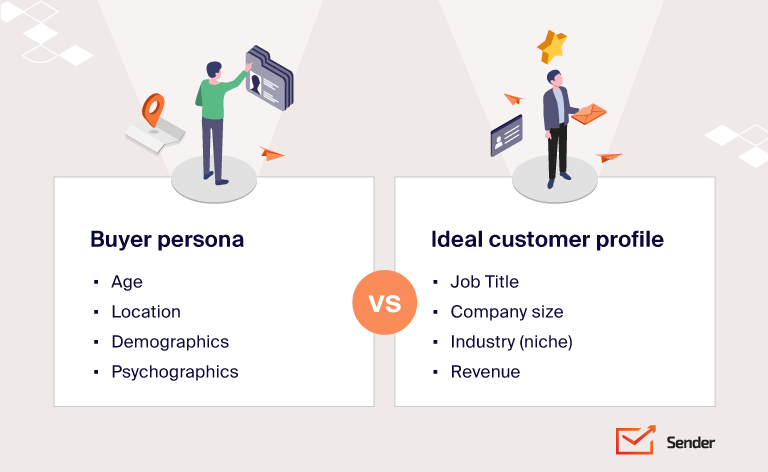
3. Clean Mailing List
Filtering the list of subscribers is also productive email marketing for startups that you should take into account. It seems like a conflict with the first technique, doesn’t it? However, cleaning the mailing list helps you narrow down the number of prospects who are really interested in the products or services you offer.
Pro tip: You can depend on the email open rate in the outreach and follow-up to remove unwanted emails from your email marketing database.
4. Emojis and Videos
Using emojis and videos is one of the best practices when reaching out to your subscribers. This is a decent way to engage with customers and gives them a more personalized experience. Plus, high chances are that the recipients will spend more time watching the video and have an impression of your brand.
5. Compelling Subject Line
The first thing that customers see when they receive an email notification is the subject line. Hence, it’s crucial to create a simple yet eye-catching subject line that persuades your subscribers to open and read the whole email.
Pro tip: Try creating several subject lines and analyze the open rates to determine which one(s) is the most click-worthy for customers. You can have a look at 50+ Email Newsletter Subject Line Examples here for more details.
6. Mobile Optimization
Optimizing newsletter design for mobile is one of the best practices regarding email marketing for startups. According to the Global Overview report released by Datareportal in 2021, 66.6% of the world’s population are mobile phone users.
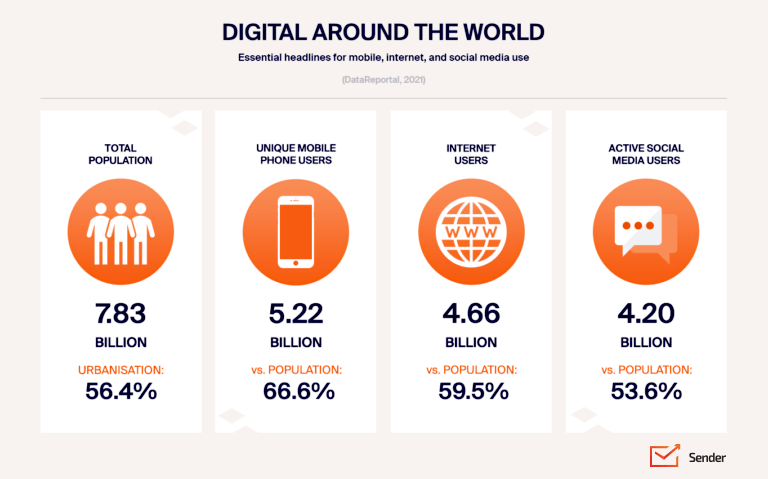
Hence, the probability that your subscribers may read emails from mobile phones is high. Besides, data collected from various mobile devices also help complete your target customers’ profiles such as:
- Geography
- Age
- Tastes and preferences
- Buying habits
- Time spent on the Internet
This helps your email marketing target the right customers easily and thus contributes to the success of the whole campaign.
Creating mobile-friendly email marketing is not a demanding task. Almost every eCommerce platform, namely Shopify and Magento, offers built-in or add-on email marketing features for store owners. You can easily create and send email to your future prospects using the well-made templates it provided.
Sender‘s email builder and templates are fully compatible and optimized for mobile, including mobile responsiveness. Each design is automatically adjusted for mobile view.
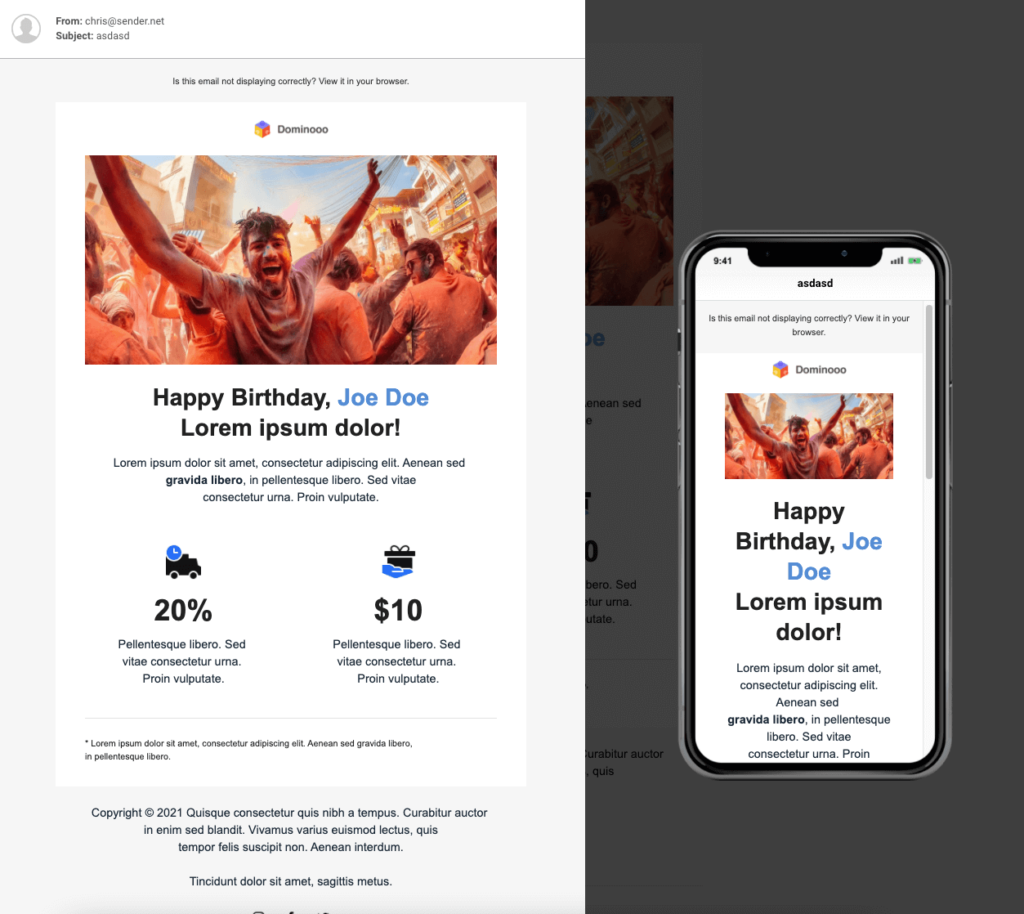
7. Powerful CTA
Displaying the call-to-action button properly is a decent way to ‘call’ your subscribers to ‘take action’: go to the checkout page and complete the order confirmation. Therefore, this is a decisive element that drives conversions for your startups.
More importantly, the CTA button turns out to be a marketing tool that evaluates the customers’ trust in your brand. Plus, you can also count the number of clicks into the effectiveness of the email marketing strategy.
Pro tip: The call-to-action button should appear in the introduction, the conclusion, and anytime you mention your products/services in the body of the email. This increases the chance that customers will click on it. And don’t forget to add a tracking code to determine which CTA attracts customers the most.
8. Collecting Feedback
Another factor that contributes greatly to the effectiveness metric of email marketing for startups is feedback from subscribers. Think of the emails opened and how your subscribers reply to your newsletters will be beneficial for your analysis.
Pro tip: Enclose a feedback form right in the email sent to your customers or on your website. Besides, you can consider creating another campaign that encourages your customers to share their experience with your brand.
Also read: How To Ask For Customer Feedback
9. Referrals
Besides collecting feedback from subscribers, startups can take the referral offer into consideration. The introduction from your current email followers to other customers will give you a chance to reach more potential clients. Plus, it builds trust among them and helps your startups to grow sustainably.
Pro tip: You can create a referral scheme that gives your existing subscribers a discount when they share your business with others.
10. Personalization
Rather than focusing on the products/services merely, more and more brands are paying great attention to offering a personalized experience to the customers. Personalization in email marketing helps strengthen your brand loyalty and increase customer retention, leading to growth in sales and revenue.
Pro tips:
- Diversify your email lists: Divide your subscribers into smaller groups depending on interests, age, geography, etc., and send specific emails to them.
- Insert your followers’ names in each email: Talking to the recipients with their names is an effective way to personalize your marketing campaigns, but try not to insert it too much.
- Create incentives: It can be a special offer for your top clients or a birthday greeting with an attractive coupon on their birthday.
- Choose the right time to send email: It would be annoying if your customers received email notifications when they’re off duty, isn’t it? Hence, make sure to send the email when your subscribers are ready to open and read it.
11. A/B Testing
As a startup, you may not have enough data to analyze the profile of your subscribers. Hence, you need to carry out A/B testing to make sure that the email marketing campaign is working productively. Besides, this method also helps you figure out what makes your email unable to grab the recipients’ attention and add some modifications for better results.
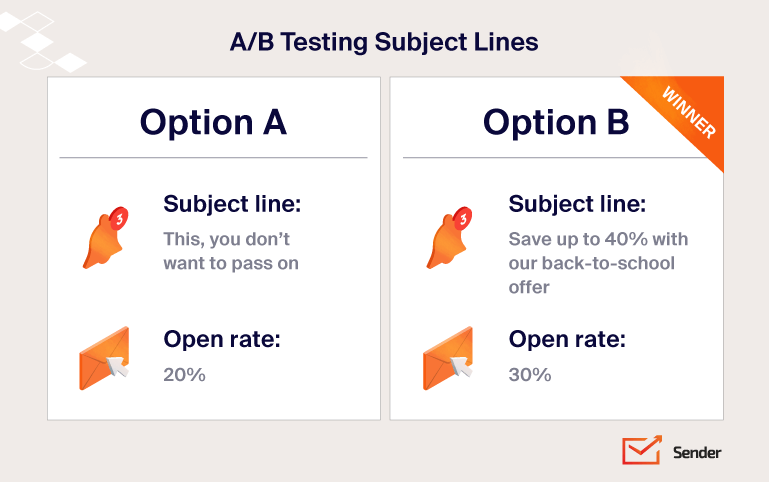
Pro tip: You can create 2 or several versions of your email templates and send them randomly. Then, take note of the open rates and track the recipients’ actions to determine their interests. Gradually, you’ll find which template is your cream of the crop.
12. Email Sequences
Depending on the product or service that you’re offering, you’ll have a specific buyer persona that is different from the others. Hence, there should be a set of emails especially customized for your subscribers.
Let’s take a look at some emails that are highly recommended for startups when it comes to email strategy:
- Welcome email. An automatic email sent to your website visitors when they sign up to your subscriber list.
- Onboarding. A series of emails that your followers will receive after the welcome email. These emails should provide information about the features and benefits of your product/service.
- Newsletter. A value-added email that helps your startup increase brand awareness. The newsletter includes tips, tricks, or tools that benefit the recipients even when they don’t order anything from you.
- Sales and product launches. Remind the subscribers about the product/service you offer. This type of email works well when you want to build a transactional relationship with subscribers.
13. Spam Prevention
Spam prevention is a critical aspect of email marketing for startups. When setting up their email marketing campaigns, startups must ensure their emails are not marked as spam or sent to the recipient’s junk folder.
Some best practices for spam prevention include:
- Using a reputable email service provider
- Ensuring that recipients have opted-in to receive emails
- Providing a clear and easy way for recipients to unsubscribe
- Including a physical address in the email
- Avoiding certain keywords and phrases that are commonly associated with spam.
By following these best practices and ensuring that emails are not marked as spam, startups can improve deliverability, build trust with recipients, and ultimately increase the effectiveness of their email marketing campaigns.
What Emails Should You Send?
Now that you understand the enormous value that email marketing can provide for your startup, let’s take a look at some examples of emails you should be sending.
Welcome Emails
A welcome email is the first email subscribers receive when they sign up for a startup’s email list. It’s a crucial email that sets the tone for the rest of the email marketing campaign.
Begin the email with a warm greeting, thanking the recipient for signing up and expressing enthusiasm about having them as a subscriber.
Use the welcome email as an opportunity to introduce your startup’s brand and values. Explain what your startup does, what sets it apart from the competition, and why the recipient should be excited to receive your emails.
Let the recipient know what kind of content they can expect to receive from your startup’s email marketing campaigns. This could include updates about new products or services, exclusive discounts, or helpful tips and advice.
Include a CTA. Encourage the recipient to take a specific action, such as visiting your startup’s website, following your social media accounts, or sharing the email with their friends.
Include a photo or video of your team or founder to add a human touch and build trust with the recipient.
Here’s a nice example of a Welcome email by Supergoop:

Key Takeaways:
- Introduce your brand and set expectations.
- Encourage the subscriber to take a specific action and personalize the email with their name and interests.
- Keep the email concise and humanize your brand by including photos of your team.
Onboarding Emails
An onboarding email series is a sequence of emails that are sent to new subscribers over a period of time, often a few days or weeks after they sign up for the email list.
The goal of the onboarding email series is to provide subscribers with valuable content, introduce them to different aspects of the startup’s brand, and help them get the most out of their subscription.
The onboarding email series is designed to build a deeper relationship with the subscriber and encourage them to engage with the startup’s brand over the long term.
The content of onboarding emails is designed to provide subscribers with valuable information about the startup’s brand, products, or services. It should help them understand what the startup does and how it can help them.
Onboarding emails may include educational content, such as blog posts, tutorials, or webinars, that help subscribers get the most out of their subscriptions. They may also include personalized content, such as product recommendations based on the subscriber’s interests or preferences.
Overall, the content of welcome emails is typically brief and introductory, while the content of onboarding emails is more detailed and educational.
Here’s the example of Shutterstock:
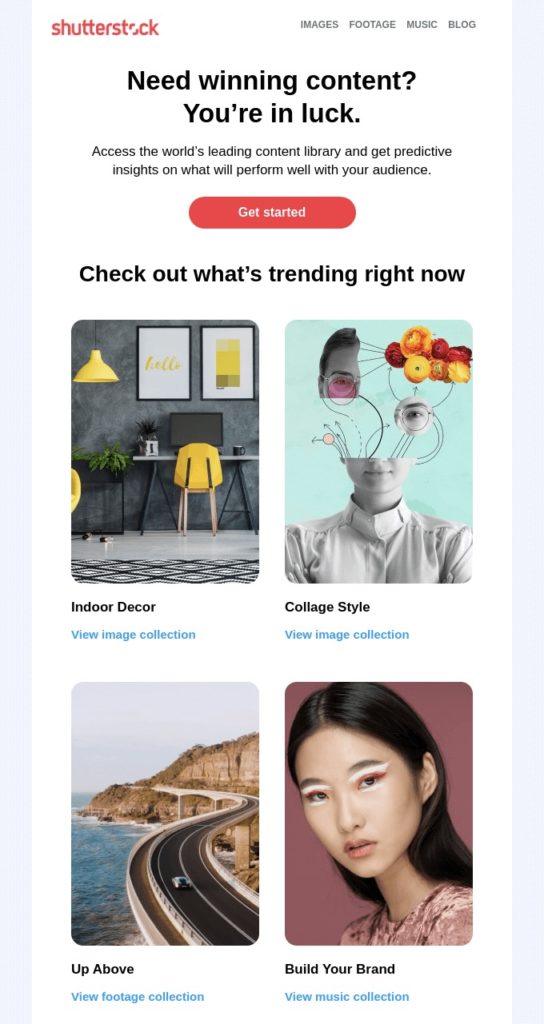
Key Takeaways:
- Send a sequence of emails to new subscribers to introduce and engage them;
- Include educational content to help subscribers maximize the benefits of their subscription or product;
- Personalize the content based on subscribers’ interests or preferences;
- Differentiate welcome emails (brief and introductory) from onboarding emails (detailed and educational).
Announcement emails
An announcement email is a message that startups send to their customers to inform them about things like new product releases, updates, or events.
It’s a way to share exciting news with your audience and get them interested in your offer.
To write a great announcement email, you need to include a few key things. First, ensure your subject line is catchy and grabs the reader’s attention. You want them to open your email and read what’s inside.
Next, explain what the email is about and why it’s important for your customers to know. Will your new product or service solve a problem they’ve been having? Will your event provide them with valuable information or entertainment? Let them know what’s in it for them.
Then, give them a brief description of the product, service, or event. You don’t need to include every little detail, but give them enough information to pique their interest. Use images or videos to make your announcement even more engaging.
Finally, end your email with a call to action. What do you want your customers to do next? Do you want them to buy your product, register for your event, or learn more about your service? Make it easy for them to take the next step by including a link or button they can click.
Announcement email from Uber:
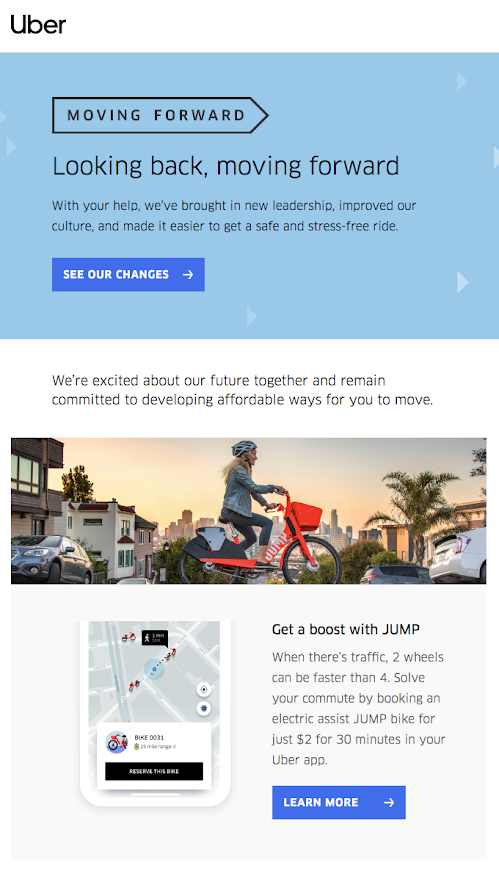
Key Takeaways:
- Clearly explain the purpose and value of the announcement;
- Provide a brief and compelling description of the product, service, or event;
- Include visuals such as images or videos to enhance the announcement’s appeal;
- End with a strong call-to-action that guides recipients on the desired next step.
By following these tips, you can create an announcement email that gets your customers excited and engaged with your business.
Sales promotion emails
Promotional emails are emails that startups send to their customers with the goal of getting them to make a purchase or take a specific action. They usually include incentives like discounts or special deals to encourage customers to buy.
These emails should have clear and concise calls to action that prompt the recipient to take action within a certain timeframe.
To create successful promotional emails, there are a few key things to keep in mind.
First, personalize the email subject to make it more likely that the recipient will open it. Second, keep the email short and to the point with simple language that’s easy to understand.
Third, focus on a single message to avoid overwhelming the recipient. Fourth, make sure the email is mobile-friendly so that it’s easy to read on any device.
Finally, thoroughly proofread the email to catch any mistakes that could damage your credibility.
Sales promotion for Cyber Monday from Taylor Stitch:
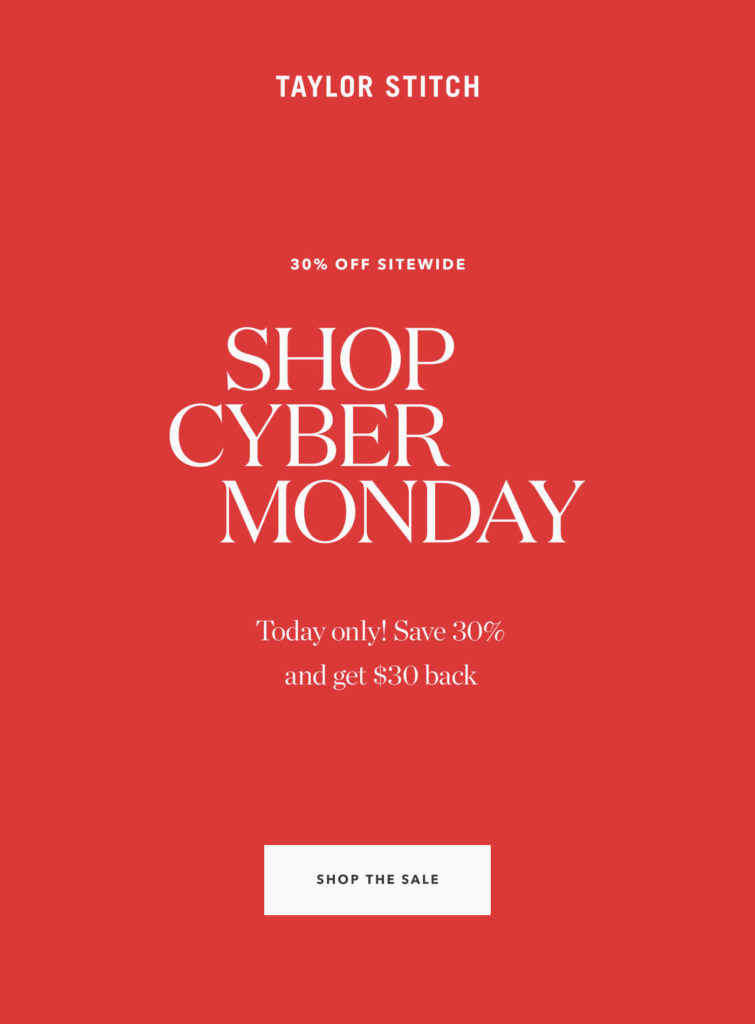
Key Takeaways:
- Make sure to identify who the email is from clearly.
- Write an attention-grabbing subject line that will entice the recipient to open the email.
- Focus on the main message or offer you want to promote.
- Include a clear call to action that encourages the recipient to take action.
Well-crafted promotional emails can convert subscribers into paying customers and turn customers into loyal brand supporters.
Key Takeaways: Email Marketing for Startups
Email marketing is great for startups to promote their products or services because it’s cost-effective and allows them to establish brand awareness and drive website traffic easily. By following best practices and measuring campaign success, startups can leverage email marketing and not only reach, but also exceed their marketing KPIs.
Also read:
- Email Marketing for Designers: Step-by-Step Guide to Success
- Email Marketing for SaaS: 15 Strategies to Follow in 2025
Author Bio
Lauren joined the Empire Flippers team as a content specialist in August 2021. She started off her career as a Graphic Designer & Copywriter, then worked as a Financial Adviser before returning to her marketing roots with Empire Flippers. Empire Flippers is an Inc. 5000 company and the #1 curated marketplace for buying and selling established, profitable online businesses.





